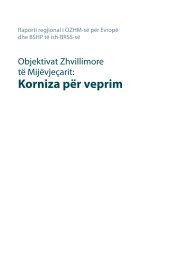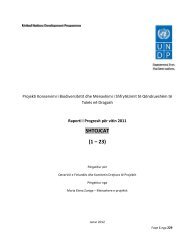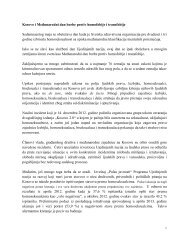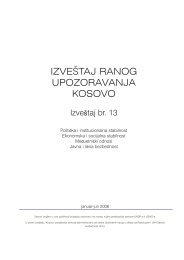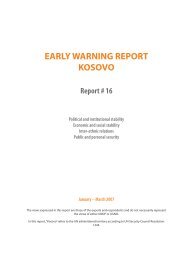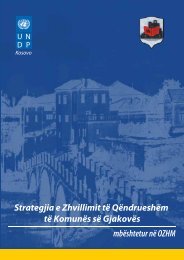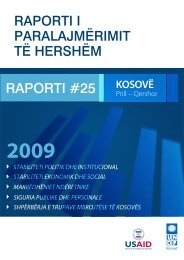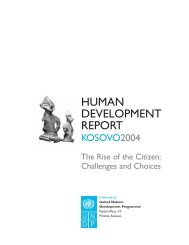Kosovo Human Development Report 2010 - UNDP Kosovo - United ...
Kosovo Human Development Report 2010 - UNDP Kosovo - United ...
Kosovo Human Development Report 2010 - UNDP Kosovo - United ...
Create successful ePaper yourself
Turn your PDF publications into a flip-book with our unique Google optimized e-Paper software.
ANNEX 1<br />
Life in <strong>Kosovo</strong> <strong>2010</strong>: A Snapshot<br />
• The <strong>Human</strong> <strong>Development</strong> Indicator<br />
for <strong>Kosovo</strong> has increased from<br />
0.740 in 2006 to 0.777 in <strong>2010</strong>.<br />
However, it is important to note<br />
that, using the new methodology<br />
as per the Global <strong>Human</strong> <strong>Development</strong><br />
<strong>Report</strong> <strong>2010</strong>, the <strong>Kosovo</strong><br />
HDI has been calculated at 0.700<br />
in <strong>2010</strong>. The growth of the overall<br />
HDI value was strongly influenced<br />
by the GDP index growth during<br />
the time-period of 2000-2007 and<br />
a significant increase in the number<br />
of high schools and university<br />
education facilities.<br />
• Life expectancy at birth has increased<br />
from 67 years in 2005 to 69<br />
in 2008, while the perinatal mortality<br />
rate has decreased from 29.1<br />
per 1000 live births in 2000 to 19.3<br />
in 2009. The overall immunization<br />
coverage has improved tremendously,<br />
from a very low 19 – 40 percent<br />
coverage rate following the<br />
1999 conflict, to above 95 percent<br />
<strong>Kosovo</strong>-wide in 2009.<br />
• There are high levels of unemployment.<br />
It is estimated that about 48<br />
percent of the labour force was unemployed<br />
in 2008, while the unemployment<br />
rate for youth stood at<br />
73 percent. Unemployment tends<br />
to be long-term, where nearly 82<br />
percent of the unemployed are out<br />
of work for more than 12 months.<br />
• A relatively high number of house-<br />
holds (7.6 percent) are unemployed<br />
and do not own a business<br />
or arable land. 42.7 percent of<br />
households do not have business<br />
or arable land but they do participate<br />
in the labour market. Employment<br />
alone does not protect from<br />
poverty as 6.4 percent of poor<br />
households had employed members.<br />
• Poverty is widespread. About 45<br />
percent (just over 2 in 5 Kosovans)<br />
live below the poverty line (set<br />
at 43 EUR per month). Poverty is<br />
higher among those living in large<br />
families, those living with many<br />
unemployed members, and those<br />
who have low education levels.<br />
The poor are also geographically<br />
concentrated in rural areas and in<br />
a few regions of <strong>Kosovo</strong> such as<br />
the Prizren/ and Gjilan/Gnjilane regions.<br />
• In the Prizren region, Dragash/Dragaš<br />
and Malishevë/Malisevo have a higher<br />
incidence of exclusion from factor<br />
markets with respectively 22.5 percent<br />
and 15.5 percent of households<br />
excluded from all factor markets,<br />
while in the Gjilan/Gnjilane region,<br />
Viti/Vitina had a higher incidence of<br />
exclusion from factor markets with<br />
18.6 percent.<br />
• Health indicators of the population<br />
are poor. Health indicators in <strong>Kosovo</strong><br />
are among the worst in Europe.<br />
Life in <strong>Kosovo</strong> <strong>2010</strong>: A Snapshot | 101



